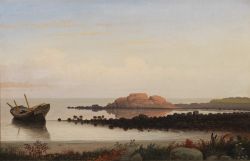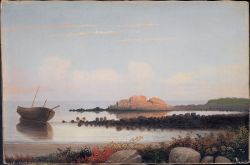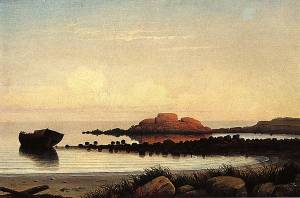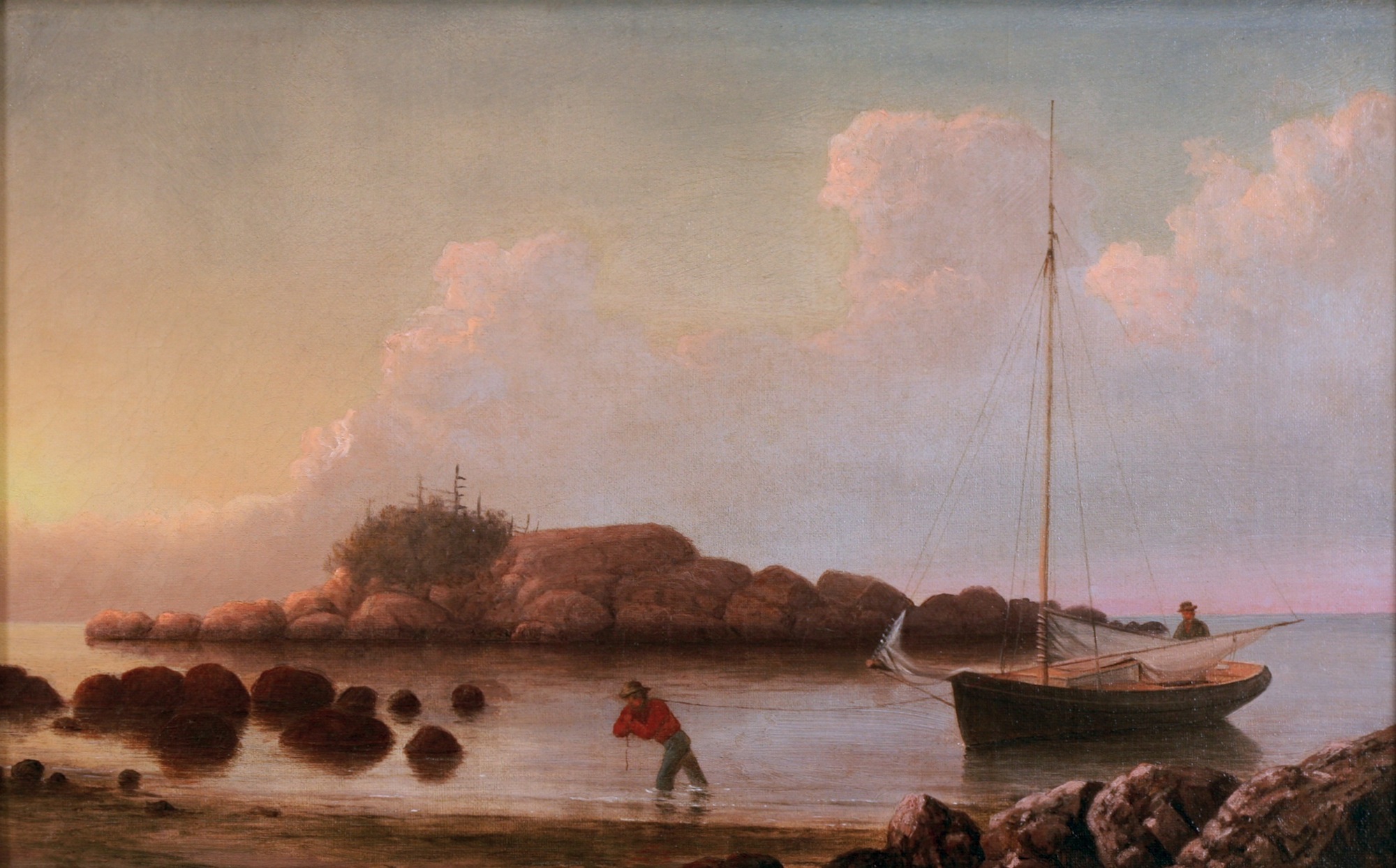An online project under the direction of the CAPE ANN MUSEUM
Brace's Rock Series
| Cape Ann Museum, Gloucester, Mass., Gift of Harold and Betty Bell, 2007 (2007.10) |
National Gallery of Art, Washington, D.C., John Wilmerding Collection, Promised Gift |
Private collection, Boston |
The Brace’s Rock series of paintings is thought to comprise Lane’s last dated oils, painted in the fall and winter of 1863–64, not long before his death in August of 1865. Paintings of unusual peace and harmony, they present a fitting finale to Lane’s evolution as a painter. Each one is as much an ode to the bittersweet recollections of a late summer afternoon as it is a depiction of a familiar Gloucester landmark. Lane accomplished this without abandoning any of his fidelity to accurate depiction of place, season, and time of day.
Numerous writers have noted the symbolism of the decaying hull foundered on the rocks and the ebbing tide as markers of Lane's awareness of his own mortality. The paintings evoke an inescapable feeling of ennui in the preternatural calm of the sea, the limpid humidity of the still atmosphere, and the pink glow of the late afternoon sun off Brace's Rock. Knowing that these are Lane's last paintings, done in failing health in his studio throughout the course of his last winter, the viewer cannot escape the feeling that these paintings were a eulogy to his beloved Gloucester shoreline.
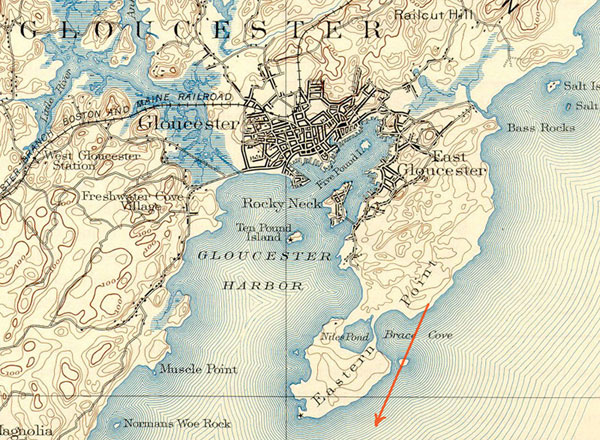 [Fig. 1] Brace's Rock sits off the shore of Eastern Point. The red arrow indicates Lane's sight line from the beach. |
Brace's Rock protrudes off the eastern shore of Eastern Point at the mouth of Brace's Cove [Fig. 1]. In Lane's day this was still a wild, uninhabited place, a part of the privately owned Niles Farm, and was unvisited by tourists and unsuited for maritime interests. Brace's Cove, with its lovely crescent beach, is small and deceptively peaceful, set in the otherwise rockbound coast of the eastern arm of Gloucester harbor, about a mile north of the harbor entrance.
Belying the serenity of Lane's paintings, Brace's Rock (including the cove and the ledge forming its northern arm) is historically one of the worst sailing hazards on the entire New England coast. It has been the scene of uncounted shipwrecks and loss of life since, from the sea, it deceptively appears to be an entrance to Gloucester harbor. Nowhere on Cape Ann is the illusion of a peaceful ocean more pronounced than Brace's Cove seen on a still summer afternoon.
Lane made his initial sketch of Brace's Rock in August, 1863, in the company of his friend Joseph Stevens, with whom he had just returned from what was to be his last voyage up the Maine coast to Portland Harbor. The sketch is an accurate depiction taken from the shore north of the cove, looking south over the foreground ledge to Brace's Rock [Fig. 2]. As is common with Lane's sketches, there are no reflections in the water, no clouds, and no color notes. The time of day is minimally noted by a few shadows, and none of the shipwrecked vessels shown in the final paintings are drawn.
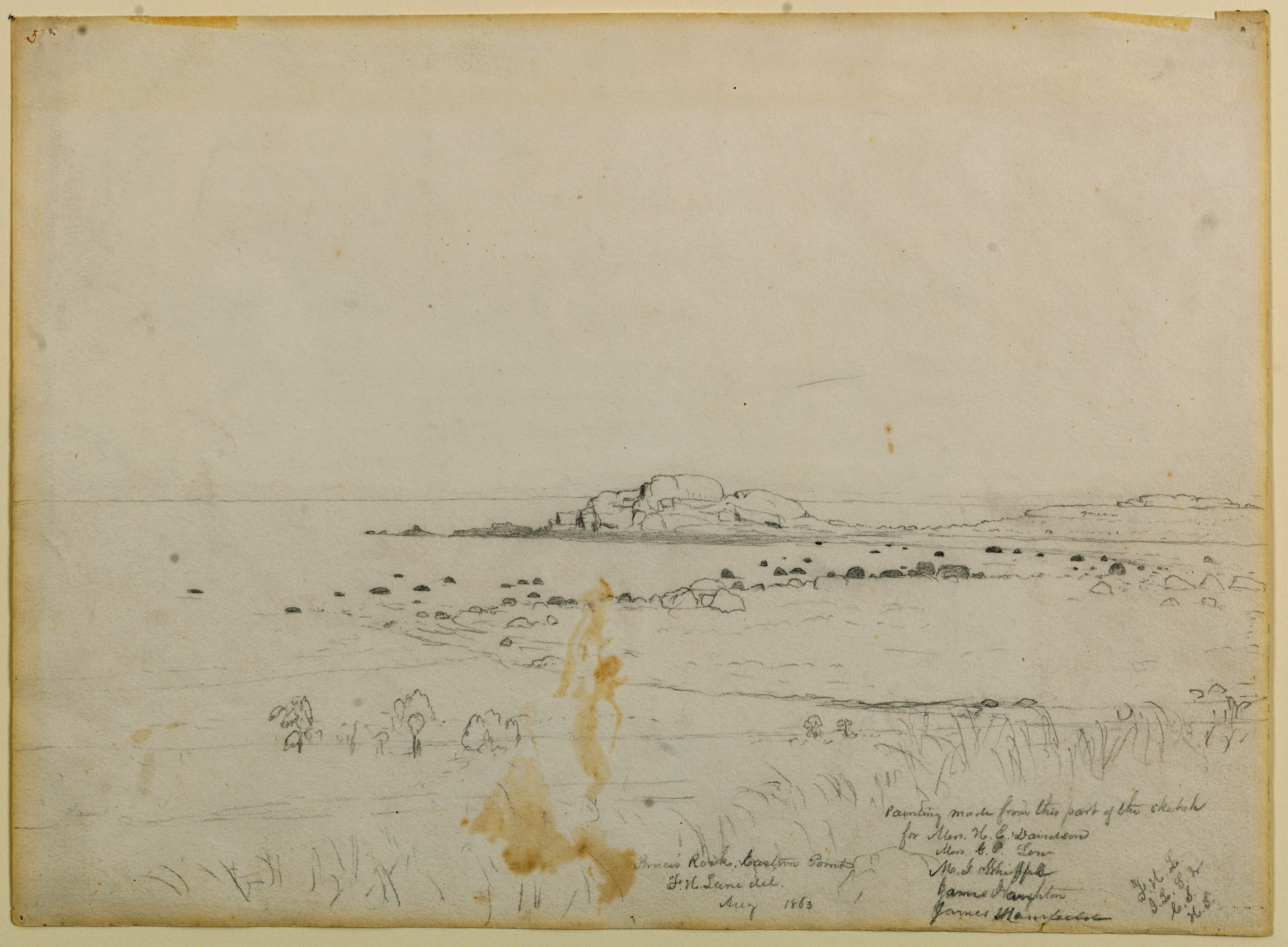
[Fig. 2] Brace's Rock, Eastern Point, 1863 (inv. 146), 10 1/2 x 15 in. Sketched on the site, Lane’s initial drawing is an accurate depiction.
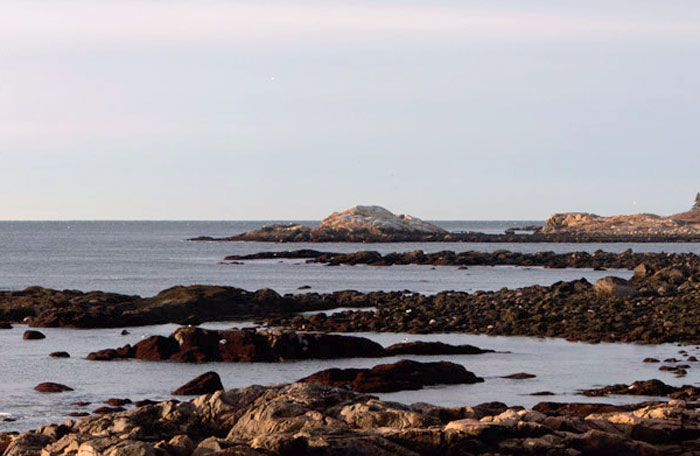 [Fig. 3] Brace's Rock, Brace's Cove, Gloucester. Photo © 2011 Winston Boyer. |
|
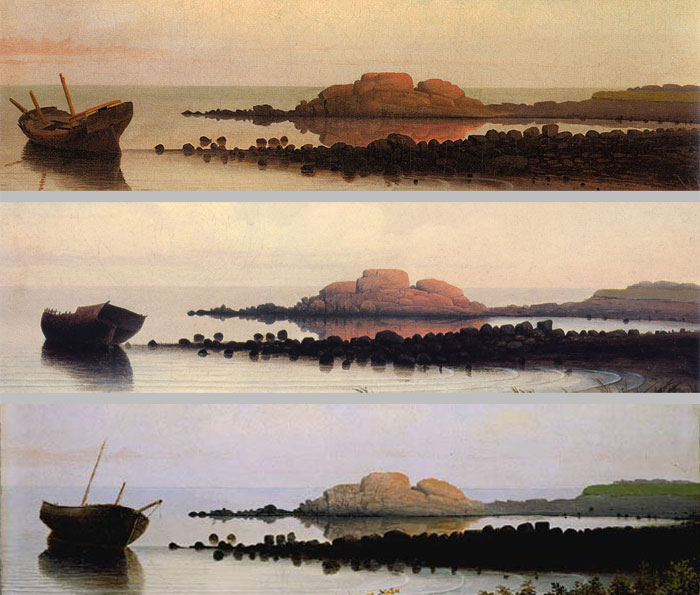 [Fig. 4] The horizon line has been lowered slightly approximately 1.5 centimeters in the Private Collection version and 3 centimeters in the NGA version. |
Lane added all these missing elements later in his studio, a remarkable accomplishment testifying to his unusually acute recall of the nuances of light and atmosphere of a particular time of day and season.
Lane completed five known paintings from his initial sketch, likely for some of the six clients noted by Stevens on the drawing. Three of the paintings are similarly composed; all three include subtle nuances of light, atmosphere and reflection, and qualify as late masterpieces in Lane's oeuvre.
The compositions are reasonably faithful to the drawing, though the viewer of the paintings is brought closer to Brace's Rock. The foreground shoreline has been subtly adjusted so that the sandy beach describes a more harmonious arc; it leads the viewer's eye into the composition. Each of the three paintings contains a wrecked vessel on the ledge, but all differently composed: two vessels pointing out to sea though leaning in different directions, one ship pointing inward. Lane is never the slavish copyist, and each of these three versions has numerous subtle variations that show Lane to have been as attentive and sophisticated in his paint handling and conception as at any time in his life.
The Cape Ann Museum (CAM) version may have been the first painting of the series, according to recent research published by the Cleveland Museum of Art. The basis for that theory is that in this painting, the height of the horizon line—relative to the bluff on the right that connects to Brace's Rock—matches perfectly to the field sketch [Fig. 2]. In the other two versions of this composition (National Gallery of Art and Private Collection) the horizon line has been lowered slightly: approximately 1.5 centimeters in the Private Collection version and 3 centimeters in the National Gallery of Art (NGA) version [Fig. 4]. The lower horizon line serves to accentuate the height and compositional presence of Brace's Rock itself, leading to the theory that Lane painted the CAM version first, wanted the rock to have more presence, and progressively lowered the horizon line in the two subsequent versions.
Note the differences in the vessels between the three versions. In the CAM painting, the wrecked vessel is pointing out to sea, leaning on its left side, showing the broken deck and two masts. In the two other versions, the ships are leaning on their right side, one facing towards shore, the other facing out to sea, but both showing only their hull undersides. In the NGA version the ship has two masts, in the Private Collection version both masts are gone.
If it is true that Lane painted the NGA and Private Collection versions after the CAM painting, it is interesting to note that he chose, in the later paintings, to focus on the exposed hulls of the wrecked vessels listing away from the viewers. As such, they present their hulls as pure volumetric forms in contrast to the natural setting. Lane was an unparalleled master at painting vessels of all kinds, as was so often noted by ship's captains, mariners and even art critics of his day. His ability to show a vessel's volume, weight and substance below the waterline was integral to the way his ships sit unerringly in the water. Here he displays the same mastery of hull form and substance: one feels a shipwright could build these vessels precisely from the paintings alone, and would know the weight and size of the keel in proportion to the width, height and bow of the ribs. The subtle gradations of dark tones in the hulls' shadows and the delicate highlights of the late afternoon sun on the ships' outlines are equally masterful.
Lane often used the device of the wrecked ship in his late paintings, as did many other nineteenth-century painters. These wrecks are commonly thought to represent the transient nature of time. In the Brace's Rock series, this device is particularly effective in creating the sense of melancholy and loss so palpable in these paintings. One cannot help but notice how beautifully these shipwrecked hulls are conceived and painted, as if the master is once again finding a way to shape and paint his favorite subject, whatever its use in the overall composition.
The foreground of the three paintings also shows variations developed in the studio [Fig. 5]. The CAM painting shows Lane's typically beautiful mix of shoreline bushes and grasses interspersed with granite boulders fronting the crescent beach. Some of the leaves have turned red and yellow, corresponding to the late summer season and also enlivening the dark greens and grays of the foreground shadow.
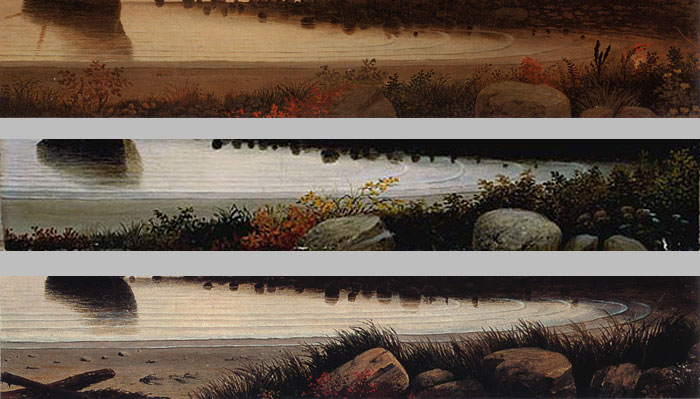 [Fig. 5] The foreground of the three paintings also shows variations developed in the studio. |
The NGA painting foreground shows a similar mix and positioning of foliage and rock, but here Lane has expanded the foreground somewhat vertically, made the boulders more prominent, brightened the red and yellow leaves and connected the bushes on the lower right to the boulder ledge that heads out into the sea.
The foreground in the Private Collection painting is quite different from the other two. Lane has added dark-green sea grasses, and removed almost all the bushes, keeping only a smattering of red and yellow leaves. He has further developed the size and presence of the foreground boulders, and opened up the lower left foreground to the beach. There, he has laid two of the wrecked ship's timbers in a cross, one member of which leads the eye directly to Brace's Rock glowing in the distance.
The skies are subtly different in all three versions as well. Lane almost never drew in skies or cloud formations in his field sketches. He apparently knew clouds, light and weather as well as he knew boats, because his depictions of skies over his entire career show great variety, nuance and accuracy to the particular characteristics of Cape Ann weather. The late afternoon humidity and stillness of these skies is very similar across all three paintings. The CAM and NGA skies are most alike, showing just minor variations in the positioning and coloration of the clouds. The high stratus clouds pick up the afternoon rays while the lower-level cumulus clouds on the horizon have been positioned so that their highest tops accentuate the high points of Brace's Rock and the wrecked vessels. The Private Collection version shows the higher cumulus moved just off the centers of Brace's Rock and the vessel. At the same time, it shows somewhat less pink and orange in the sky.

Brace's Rock, 1864 (inv. 73), 10 1/4 x 15 1/4 in. Terra Foundation for American Art, Daniel J. Terra Collection, Chicago (1999.83).
This version of Brace's Rock is an anomaly in the series (Brace's Rock, 1864 (inv. 73), Terra Foundation for American Art, Daniel J. Terra Collection, Chicago (1999.83)). The other paintings are taken directly from the field sketch and are faithful to it—to the extent that any Gloucester resident would immediately recognize the scene. With this painting Lane has turned Brace’s Cove on its head, and while the rock, though reversed, is clearly recognizable, the other features—the sandy cove, the foreground bushes and the reef at low tide—simply don’t exist on that side of Brace’s Rock. The coast immediately south of Brace's Rock is comprised of steep granite cliffs dropping straight into deep water. It is hard to imagine Lane with his infirmities and failing health getting anywhere near the vantage point necessary to make a drawing of Brace's Rock from this angle, though he could have seen it from a boat sailing along the coast.
The rest of the scene simply does not exist and has been invented, lending the painting a surrealist feel. This is partially due to the juxtaposition of the incongruous landscape elements, but the perspective is also a bit skewed. The foreground cove with the abandoned vessel and the spit of land coming in from the right have a different vanishing point than Brace's Rock and the dark line of rocks. These seem to hover over the still cove as if in a parallel universe. Adding to the surrealist quality is the abandoned and rotting vessel on the beach, which looks as if a summer party stepped ashore for a picnic years ago and never returned.
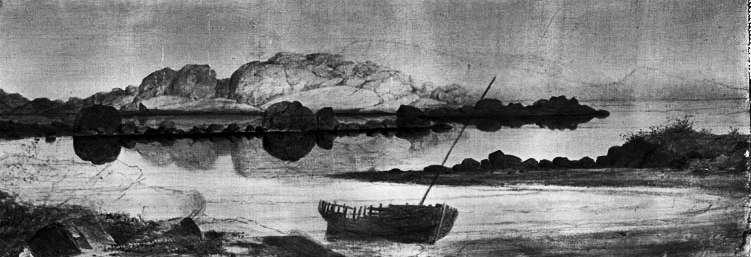
Infrared image of Brace's Rock, 1864 (inv. 73). Courtesy Cleveland Museum of Art.
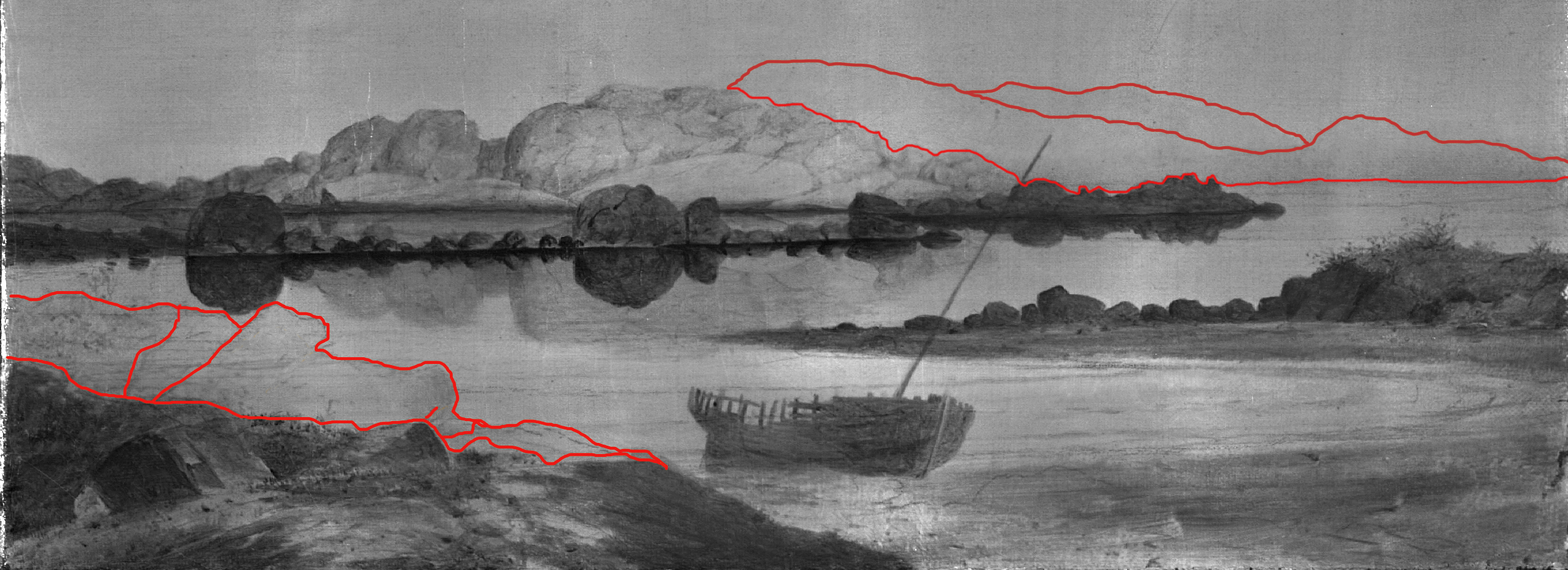
Infrared image of Brace's Rock, 1864 (inv. 73) with underdrawing of mountains and rocks outlined. Courtesy Cleveland Museum of Art.

Camden Mountains from the South West, 1855 (inv. 170), 10 3/4 x 25 in. Cape Ann Museum.
While idealized or invented landscapes were common in nineteenth-century American art, for Lane they were very unusual. He had at least five commissions for Brace’s Rock paintings from his drawing, and presumably any patron who had commissioned a work would know the scene and expect a reasonably faithful representation. Infrared photography by the Cleveland Museum of the drawing on the canvas under the painting may have solved this mystery (see above scans).
The underdrawing shows mountains on the horizon identical to the Camden Hills in Maine, a subject Lane painted and drew numerous times. There are also major changes to the foreground cove and rocks, all well beyond Lane’s usual minor adjustments. On first seeing the underdrawing, Lane scholar John Wilmerding immediately connected the hills in the background with the Owl’s Head masterpiece of 1862, painted just two years before this work (see below). The foreground cove is also similar to those along the shore of the island from which Lane took the Owl’s Head view.
Is the mystery as simple as Lane having had a canvas of an identical size to the other Brace’s Cove paintings in his studio on which he had started and then abandoned an Owl’s Head painting? Did he then leave the beach, rocks and foreground boat in place, paint out the mountains and add the reef and Brace’s Rock, but facing the other way because the position of the beach and boats demanded it? That could also explain the oddly different worlds and perspective of the beach from the rock and reef beyond: they were painted at different times in different paintings.
 Brace's Rock, Eastern Point (inv. 554), 5 1/4 x 8 1/2 in. Private Collection. |
|
|
|
This is an interesting subject for speculation, all the more so for its being so unusual in Lane’s work. After all, he made interesting variations in three of the other versions, and six identical copies of anything can be tedious, even for Lane. He may have taken a convenient shortcut. Whatever its genesis may have been, this is a strange and wonderfully realized painting. Lane clearly spent time and effort on it and considered it a finished work worthy of signing and dating.
The two other paintings usually included in the series are quite different. The first, shown on the left, Brace's Rock, Eastern Point, is quite small, 8 x 10 in., and has a sketch-like quality in its looser brushwork and the way the image is positioned, using the (canvas, board?) to provide a framing surround. The other elements of the drawing are all here, though much truncated in the manner of a sketch where the main elements are roughly positioned to test the composition. The major difference is that here the sun is rising in the east, casting a light path to the beach. If this was a preliminary sketch, it is interesting that, by removing the sunrise and lighting the rock from the western side in late afternoon in the later works, Lane has more effectively put the focus entirely on Brace's Rock and its monolithic presence in the still cove.
The other painting, Coming Ashore near Brace's Rock, Gloucester, Massachusetts, c.1860 (inv. 60), Gloucester, Massachusetts, has a less clear connection. It is the same size as two others in the series, 10 x 15 in., but the composition is completely different. Like the Terra painting, it shows a non-existent cove to the south of Brace's Rock, here with a man hauling a boat ashore. While the rock superficially resembles Brace's Rock, it is much smaller and has a few trees growing out of it, unlike the original. The sun is off to the left, which could be a sunrise on the Eastern Point shore, but is far north of actual. There are many islands in the bays of Maine that Lane sailed in that have similar rock formations to this, and that would be much more likely to have beaches and coves positioned along those many miles of shoreline. The treatment of the rocks, particularly those covered in seaweed in the water, have a softer and less distinct quality that could indicate Mary Mellen's hand. While this work is signed by Lane, it joins a number of other signed Lane works that show enough of Mellen's stylistic characteristics to suggest a collaboration.
The author would like to thank H. Travers Newton, an independant scholar, and Marcia Stele, Chief Conservator of the Cleveland Museum of Art for their invaluable work and insight on these paintings in Fitz Henry Lane's Series Paintings of Brace's Rock: Meaning and Technique published by the Terra Museum of American Art which this essay has liberally referenced.
